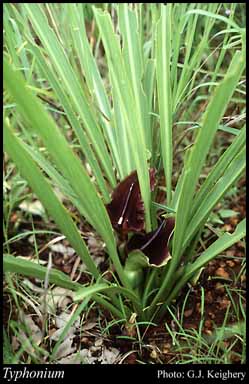- Reference
- Wiener Z.Kunst p 732 (1829)
- Name Status
- Current







Scientific Description
Family Araceae.
Habit and leaf form. Herbs; evergreen, or deciduous; laticiferous. Perennial. Leaves basal. Plants with a basal concentration of leaves, or with neither basal nor terminal concentrations of leaves; stem a tuberous, sometimes branching, often proliferating rhizome or well-defined hemispherical corm, rarely stoloniferous. Helophytic, or mesophytic. Not heterophyllous. Leaves small to very large; alternate; spiral, or distichous; petiolate (appearing conventionally ‘petiolate’ when the sheath shed); sheathing (the sheath membranous). Leaf sheaths with free margins. Leaves with ‘normal’ orientation; simple. Leaf blades entire, or dissected (then deeply lobed); pinnately veined, or palmately veined, or parallel-veined; cross-venulate; hastate, or sagittate. Leaves ligulate, or eligulate. Axillary scales present, or absent. Leaves without a persistent basal meristem. Vegetative anatomy. Plants without silica bodies. Leaf anatomy. Guard-cells not ‘grass type’. Stem anatomy. Secondary thickening absent. Roots. Roots with velamen, or without velamen.
Reproductive type, pollination. Fertile flowers functionally male and functionally female. Unisexual flowers present. Plants monoecious. The unisexual flowers aggregated in different parts of the same inflorescence. Female flowers aggregated in ‘inflorescences’; without staminodes. Male flowers aggregated in ‘inflorescences’; without pistillodes. Anemophilous, or entomophilous. Pollination mechanism conspicuously specialized, or unspecialized.
Inflorescence and flower features. Flowers aggregated in ‘inflorescences’; in spikes. Inflorescences simple (solitary). The terminal inflorescence unit seemingly racemose. Inflorescences scapiflorous, or not scapiflorous; shortly pedunculate; spadix densely flowered, with a basal zone of female flowers below a contiguous zone of neuter organs, then, usually separated by a naked zone, a staminate zone, then a sometimes stipitate appendix; pseudanthial; spatheate (spathe convolute below into a usually swollen, mostly greenish, sometimes ribbed basal portion, housing the female and sterile organs, separated by a constriction from a flag-like, more or less spreading to coiled, withering limb). Flowers ebracteate; ebracteolate; small (numerous); (these or the spadix) fragrant, or malodorous; cyclic. Perianth absent. Fertile stamens present, or absent (when female). Androecium 1–5. Androecial members coherent. Androecium exclusively of fertile stamens. Stamens 1–5. Anthers basifixed; non-versatile; dehiscing via pores, or dehiscing via short slits; extrorse; bisporangiate, or tetrasporangiate. Pollen shed as single grains. Fertile gynoecium present, or absent (when male). Gynoecium 1–8 carpelled. The pistil 1 celled. Gynoecium monomerous, or syncarpous; of one carpel, or eu-syncarpous; superior. Carpel apically stigmatic. Ovary unilocular; 1 locular. Gynoecium shortly stylate, or non-stylate. Styles apical. Stigmas wet type, or dry type; non-papillate; Group II type. Placentation basal. Ovules in the single cavity 1–2; pendulous, or horizontal, or ascending; orthotropous.
Fruit and seed features. Fruit fleshy; orange to red; indehiscent; a berry (usually housed within the enlarged, persistent spathe base). Dispersal unit the fruit, or the inflorescence. Fruit 1–2 seeded. Seeds endospermic. Endosperm oily (and starchy). Perisperm absent. Seeds with starch. Cotyledons 1. Embryo straight (linear). Seedling. Hypocotyl internode present, or absent. Mesocotyl absent. Seedling collar not conspicuous. Cotyledon hyperphyll compact; assimilatory, or non-assimilatory. Coleoptile absent. Seedling non-macropodous. First leaf dorsiventral. Primary root ephemeral.
Physiology, biochemistry. Photosynthetic pathway: C3.
Geography, cytology, number of species. Native of Australia. Not endemic to Australia. Australian states and territories: Western Australia, Northern Territory, Queensland, and New South Wales. Northern Botanical Province.
Additional characters Leaves not solitary.
Taxonomic Literature
- Hay, A.; Barrett, M. D.; Barrett, R. L. 1999. A new species of Typhonium (Araceae: Areae) from the west Kimberley, Western Australia.
- Wheeler, J. R.; Rye, B. L.; Koch, B. L.; Wilson, A. J. G.; Western Australian Herbarium 1992. Flora of the Kimberley region. Western Australian Herbarium.. Como, W.A..